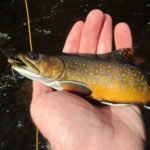It’s moose season in the north. On Facebook, some of my Canadian friends have been eagerly anticipating the season; talking about who drew a tag in the lottery and where they plan to hunt. Both topics are pertinent. Due to a crashing moose population, available hunting tags were greatly reduced in a vast portion of northwest Ontario extending northward from the Minnesota border. Hunters are moving around, trying to find moose as the animals disappear from their traditional hunting areas.
Not surprisingly, Ontario hunters place the blame for the lack of moose on something other than themselves. The Ontario Ministry of Natural Resources has been painfully slow to respond to the population decline, so hunters blame the agency. They also blame wolves, bears and Native subsistence hunters for killing too many moose. Somehow, in the course of all of this blame-laying, these hunters fail to consider the moose they kill.
Here in Minnesota, a moose hunt is happening, too. Although the state DNR hasn’t held a hunt for several years, three Ojibwe bands with treaty hunting rights in northeastern Minnesota are hunting moose this year and also did so in 2016. Although the collapse of Minnesota’s moose population has been well-documented, tribal biologists assure us the projected kill of dozens of bull moose is biologically insignificant. I have a feeling the few remaining moose hunters in Ontario and Minnesota give scant consideration to the significance of their individual actions.
At times, wildlife management seems to be guided by a science of convenience. Sometimes we are told hunting harvests are compensatory mortality, meaning that creatures killed by hunters likely would have died from natural causes. At other times, we are told hunting is a management tool that biologists use to keep game populations in check. And, when we continue to hunt a species that is disappearing from the landscape, we are told hunting harvest is biologically insignificant.
While circumstances differ for the hunts of various feathered or furred game species, hunting is a lethal activity. Unlike anglers, hunters don’t practice catch and release. The culmination of a hunt is the kill. So why is it that an October angler would never consider killing the 50-inch muskie he catches because he believes doing so would harm the lake’s muskie population, yet the same fellow will kill a 10-point buck the following month and never think twice about doing so?
Wildlife management originated in an era of scarcity, when North American game populations had been nearly destroyed by habitat destruction and commercial and subsistence hunting. The intent of wildlife management was to restore game populations to a level of abundance that would allow hunters to take a surplus without affecting the overall health of the population. Over the past century, wildlife managers have been remarkably successful. Both wildlife and regulated hunting have thrived.
Nevertheless, we face ongoing challenges to maintaining wildlife populations. Human development or intensive land use may degrade or eliminate wildlife habitat. Changing climatic conditions can influence migrations, as well as wildlife use of breeding or wintering areas. Human-caused changes on the landscape can lead to competition between wildlife species, creating a situation where there are winners and losers. Sometimes those changes will cause a species to explode in abundance, creating a windfall, at least temporarily, for hunters.
Generally, wildlife managers use science to address these challenges, often with success. But there is more to wildlife management than science. Because wildlife is held in public trust, its management is overseen and to varying degrees controlled by politicians. Since hunting seems to be almost coded in our DNA, it is deeply woven in our social fabric, too. Because hunting gives them pleasure, hunters are often reluctant to make sacrifices to benefit wildlife populations. And politicians are willing to accommodate them.
When it comes to hunting, something else seems to be wired into our DNA: a lack of self-awareness. We seem incapable of considering how our individual actions are a part of the whole. How else do we explain why humans, when given the opportunity, have repeatedly hunted, trapped or fished desirable wildlife and fish populations to the point of depletion, and even extinction? Why are today’s hunters willing to accept nearly every new gadget or technique that makes it easier to find, attract or fool (and ultimately kill) their prey?
Sometimes we get guidance from wildlife managers, especially if what we are doing will affect the overall health of a wildlife population. Sometimes, usually at the behest of hunters, politicians overrule wildlife managers. And when that happens, wildlife managers may say the gadget, technique or even the hunt itself will be biologically insignificant.
Wildlife management has accomplished wondrous things. It is impossible to envision what North America would be like today without the past century’s science-based wildlife restoration and conservation efforts. That said, over years of covering and commenting on hunting and conservation, I’ve noticed something. Big, positive changes in wildlife conservation rarely originate within the scientific or political realms. Most often, they begin with the people.
We can paint with a broad brush and truthfully say most hunters lack self-awareness. But those hunters who do consider how their individual actions fit into a bigger picture are the ones who are likely to inspire change. This has been true since the era of Teddy Roosevelt, who is the first and best example of an individual hunter who made a difference.
Some wildlife issues don’t have an easy fix, such as the continuing decline of Minnesota’s and northwestern Ontario’s moose population. Moose seem to be facing a perfect storm of habitat loss, parasites and disease, and predation. If that is the case, perhaps the best things that could happen for moose would be the opening of new forest products mills to increase logging and some hard winters to knock back white-tailed deer numbers (and consequently the predators that prey upon them). None of that is likely to happen any time soon. Until it does, about all we really can do is try to keep healthy moose on the landscape. There is no such thing as compensatory mortality in a declining population. Every healthy moose killed by a hunter is one less moose in the woods.



